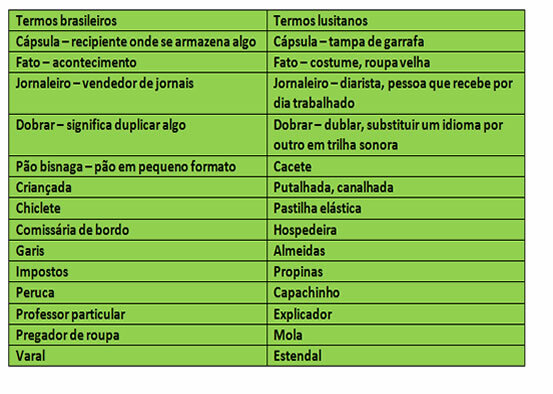Variationlinguistics is an expression used to denominate how individuals who share the same language have different ways of using it. That diversity of writing and speaking it stems from geographic, sociocultural, temporal and contextual factors, and can be justified by the brain functioning of language users as well as the interactions between them. The importance of variations lies in the fact that they are historical elements, shapers of identities and capable of maintaining structures of power.
Read more: Nominal agreement - linguistic process that is also influenced by linguistic variations
Types of language variations
Linguistic variation is a phenomenon that brings together various spoken or written manifestations of users of the same theretongue. Furthermore, its occurrence depends on the fact that words and expressions have an affinity semantics, that is, they establish a very close relationship of meaning, although they differ in terms of the phonetic aspect. (sound), phonological (function of sounds), lexical (vocabulary) or syntactic (relationship between phrase-forming terms and prayers).
Armed with the notion of what variation is, see below what its species are:
Diatopic variation (regional variation)
The diatopic variation is the one that occurs due to the geographic differences between the speakers. It can happen both between regions of the same nation, for example, Rio de Janeiro and Goiás, or between countries that share the same language, such as Brazil and Portugal.
In the case of the two States, the relationship of linguistic proximity arises from the colonization process, which resulted in the imposition of a new language on the inhabitants of overseas lands. Although the Portuguese language was and continues to be official, it has distanced itself in several aspects from that used in Europe, given that we had the influence of different languages not only from indigenous peoples but also from foreign peoples, such as the different African ethnic groups.
Such differences can be observed in the lexical fieldl. For example, surname, in Brazil, means an informal name given to someone, while, in Portugal, the term carries the meaning of surname.
In addition to this scope, we realize distinctions syntactic in both places, such as the position of the oblique pronouns unstressed (me, te, se, us, vos), since, in informal situations, we tend to put them before the verbs (Te amo!), whereas the Portuguese usually insert them after the verbs (Amo-te! ).
Do not stop now... There's more after the advertising ;)
We can also see that there is contrasts phonetic-phonological, for example, in the Portuguese country, there is a very strong marking of "l" at the end of syllables (Maria, take the "papellllll", by please!), here this phone is replaced by the "u", which triggers its weakening (Maria, take the "paper", for favor!).
Just as there are variations between Portugal and Brazil, in our territory, due to the continental dimension and cultural diversity, the use of language is modified according to the region. Therefore, we have, for example, the word “boy” in Bahia and “boy” in Rio Grande do Sul. We also noticed the use of the pronoun “tu” in some regions of Pará and the wide use of “you” in several places, such as Minas Gerais, which implies a whole syntactic transformation.
Furthermore, we found a retroflex “r”, also known as “r hillbilly” by some linguists, such as Amadeu Amaral, in Goiás (“Porrrrrrrrta”), while in Rio de Janeiro, the “r” that scrapes at the bottom of the throat.

Diastratic variation (social variation)
Diastratic variation is arising from sociocultural differences, since the fact that people have or not continuous and prolonged access to formal education and cultural goods, such as museums, cinemas, literature, concerts by singers that are highly rated by the specialized critics, lead them to express themselves in different ways.
For example, lawyers usually use more formal language when practicing their profession, considering that, in theory, they had a whole apparatus, including financial, to establish a communication more sophisticated. On the other hand, domestic workers tend to use more colloquial language structures, mainly a result of economic and, consequently, educational and cultural deprivation.
Variationdiachronic (historical variation)
The diachronic variation is result of the passage of time, as the language is constantly changing, as speakers are creative and look for new expressions to communicate more effectively. Furthermore, this phenomenon is caused by the historical processes, as the North American influence in Brazil, which implied the adoption of a series of foreignisms, like brother, in the sense of comrade, and sale,which means liquidation.
It is important to highlight that most linguistic innovations do not remain, a fact that corroborates the need to observe the crystallization of spoken and written forms only after a certain period of time.

Diamestic variation
Diamestic variation is what happens between speech and writing or between textual genres, that is, transmission supports of a given information that contains almost regular characteristics, for example, the Whatsapp and the medicine insert. It is noteworthy that the distinction between speech and writing is not static, considering that it is possible to build a written text marked by typically oral expressions and vice versa.
Thus, a distinctive element between speech and writing is the instantaneity or not of the formulation. Think about it, when you're talking to someone, the junctions between words seem very natural and formulated at the exact moment of speech, whereas the writing usually requires planning and establishes a greater possibility of conveying an accurate message if you have mastered the standard norms of the tongue.
See too: May 5 — World Day of the Portuguese Language
Why is there linguistic variation?
Linguistic variations exist due to the combination of sociocultural factors, that is, the relationships established in certain communities, and socio-cognitive factors, that is, the configurations of our brains when we use language and influence others individuals.
It is noticed that the constitution of the changes presupposes a collective adhesion, as new linguistic forms will only be incorporated if they are capable of being mentally understood by the majority of speakers and have their approval. An example of this is seen in the film Mean Girls, in which the character Gretchen tries to put on a new catchphrase “This is so clay”, but her colleague Regina warns “Stop trying to make the clay happen, this will never catch on”.
sociocultural factors
The sociocultural factors are responsible for both the language changes and the attempt to keep its statics. In this sense, we have the social institutions, like schools; the literary tradition, the grammarians and dictionary writers, and the academies of letters; the means of communication; the State with its organs and entities; and the various religions, which assume the condition of defenders of a language intimately connected to the culture. The problem lies in the issue of this culture being a product of privileged socioeconomic classes, a fact that reduces the circle of legitimate people to establish changes.
In contrast to this movement, the diversity of geographic origins, ethnicities, hierarchical positions between men and women and degrees of schooling trigger linguistic variations, as speech and writing, each in its own way, are reflections of a plural society. It is noteworthy that, as the individual has more access to formal education, the more he will be able to change the stigmatized expressions for those with acceptable status.
In addition to this situation that occurs in local contexts, it is important to note that linguistic change can also originate if a number substantial number of speakers of a particular language see themselves coerced into using a different writing and speech than their own, whether due to emigration or in virtue of domination relations, as those experienced by Brazilian Indians in relation to the Portuguese.
Sociocognitive Factors
With regard to socio-cognitive factors, linguistic economics is a crucial point in understanding the reasons for the variations. It consists of processes based on two premises: saving memory, decrease the effort caused by mental functioning and make the act of material externalization of the language easier; and enhance communicative skills based on filling the gaps present in speech and writing.
It is clear, then, that this phenomenon is responsible for a rearrangement, which removes some existing excesses in the language as well as adds other elements, which triggers a diversity of structures. An example that satisfactorily illustrates these articulatory, physiological and psychological mechanisms is the tendency to form words in which there is an alternation between vowels and consonants, for example, “cat”. This propensity generates the placement of vowels in terms that have more than one consonant together, such as "lawyer", whose proximity between the letter "d" and the "v" leads people to include the sound of “i” or “e” among them, giving rise to the phonetic variations “advogado” and “lawyer”.
Although linguistic economy is the most recognized element, it is also necessary to talk about the grammaticalization and of analogy as sociocognitive pillars of variations. The first consists in the construction of unpublished grammatical resources through the restructuring of forms already known by the speakers. Such an occurrence is observed, for example, in metaphors.
The snake has arrived. I don't know what Daiane is doing here.
Check that the term “snake” refers to the Daiane person, as she probably has a behavior as treacherous as the animal. This close relationship led the individual to construct the aforementioned metaphor.
In turn, the analogy it constitutes a mechanism for comparing the words, and, based on this, there is the establishment of similarities between them and the choice of a more common pattern. This reasoning is easily identified when preschool children conjugate some irregular verbs, that is, words that may have their stems (part that carries the main sense) and endings (final part of the word that carries information such as gender, number) modified according to the conjugation.
If I “wanted”, I would make the cake.
If I wanted to, I would make the cake.
The first verb form is recurrent in the first person of the imperfect past tense of the subjunctive, since we have the maintenance of the stem and insertion of the ending "this", for example, knead, break, eat, send, drink; while the second, despite being grammatically adequate, breaks with this common structure and presents us with a different constitution, causing, at first, strangeness and desire to adapt it to the default.
Also access: Where or where?
Importance of linguistic variation
Sociolinguistics, responsible for warning about the importance of studying the language as part of the cultural and social manifestation of a people, predicts that variations are important, as they carry the story of each community.
Thus, the differences in writing and speech constitute portraits of the ways of life of Portuguese language users. For example, in small country towns, where access to the internet, television and other means of communication and media is limited, the language it tends not to change as much as in large metropolises, where there is, in addition to a bombardment of information, contact with people from different regions.
such ability to reconstitution of the communities' habits and experiences it also contributes to drawing a parallel between the regularities of variations present in similar places, which allows the understanding of the functioning of the brain from the moment of thought to the articulation of words and expressions. Therefore, the varieties allow the understanding of the subjects' innate linguistic competence, strengthened by the desire to establish effective communications.
These communications, as they present marks of linguistic varieties, are established as structuring elements of people's identities, so the way they see themselves and analyze the world around them will bring both an individualization and a sense of belonging to a group.
Despite the positive character of this, it appears, based on the behavior of society, that variations while forming beings they are also used as instruments of stigmatization, exclusion and, consequently, perpetuation of the power of a portion of the society. In this way, linguistic multiplicity figures as a fundamental tongue oppression mechanism considered standard in relation to other modes of expression.
See too: Linguistic prejudice - rejection of less prestigious linguistic varieties
solved exercises
Question 1 - (IFPE-2017/adapted) Read the text to answer the question.

Available in:. Access: Nov. 08 2016.
About the language of the characters in TEXT, on the Facebook page “Bode Gaiato”, evaluate the assertions.
I. The verbal text, although written, reveals an approximation with orality. The spelling of the word “nãm” highlights this aspect.
II. Speakers use a language with strong regional marks, such as the choice of the word “mainha”.
III. The dialogue between mother and child reveals the formal register of language, as we can see from the use of the expressions “come here for me...” and “just like...”.
IV. The word "boizin", formed based on the English word boy, is a typical linguistic mark of social groups of young people and adolescents.
V. Since all natural languages are heterogeneous, we can affirm that the speeches of Junio and his mother reveal linguistic prejudice.
Only the statements contained in the statements are CORRECT
a) I, II and IV.
b) I, III and V.
c) II, IV and V.
d) II, III and IV.
e) III, IV and V.
Resolution
Alternative A. Item III is incorrect, as the words are not spelled according to the standard language modality. Item V is incorrect, as the two characters use similar language and are at the same socioeconomic level, so there is no one who can stigmatize the other.
Question 2 - (Enem-2017)
The Tupi language in Brazil
300 years ago, living in the village of São Paulo de Piratininga (dried fish, in Tupi) was almost synonymous with speaking an Indian language. In every five inhabitants of the city, only two knew Portuguese. Therefore, in 1698, the governor of the province, Artur de Sá e Meneses, implored Portugal that only send priests who knew “the general language of the Indians”, because “those people do not explain themselves in another language".
Derived from the dialect of São Vicente, Tupi from São Paulo developed and spread in the 17th century, thanks to isolation the geographical area of the city and the unchristian activity of the Mamluks from São Paulo: the flags, expeditions to the sertão in search of slaves Indians. Many Bandeirantes did not even speak Portuguese or expressed themselves poorly. Domingos Jorge Velho, the São Paulo native who destroyed the Quilombo dos Palmares in 1694, was described by the bishop of Pernambuco as “a barbarian who doesn't even know how to speak”. In their wanderings, these people named places like Avanhandava (place where the Indian runs), Pindamonhangaba (place to make hooks) and Itu (waterfall). And he ended up inventing a new language.
“The slaves of the bandeirantes came from more than 100 different tribes,” says historian and anthropologist John Monteiro, from the State University of Campinas. "This changed the Tupi Paulista, who, in addition to the influence of Portuguese, still received words from others languages." The result of the mixture became known as the general southern language, a kind of Tupi made easy.
ANGELO, C. Available in:. Accessed on: 8 Aug. 2012. Adapted.
The text deals with socio-historical aspects of the national linguistic formation. As for the role of Tupi in the formation of Brazilian Portuguese, it appears that this indigenous language
a) effectively contributed to the lexicon, with names relating to the characteristic features of the designated places.
b) originated the Portuguese spoken in São Paulo in the 17th century, in whose grammatical basis there is also the speech of various indigenous ethnic groups.
c) developed under the influence of the catechetical works of Portuguese priests coming from Lisbon.
d) mixed with African speeches, due to the interactions between Portuguese and blacks in the attacks against Quilombo dos Palmares.
e) it expanded parallel to the Portuguese spoken by the colonizer, and together they originated the language of the São Paulo Bandeirantes.
Resolution
Alternative A. As the text states, the indigenous language contributed to the lexicon of Brazilian Portuguese, especially with regard to the observance of the elements characteristics of the places to name them, for example, Pindamonhangaba (place to make hooks), Avanhandava (place where the Indian runs) and Itu (waterfall).
By Diogo Berquó
grammar teacher


